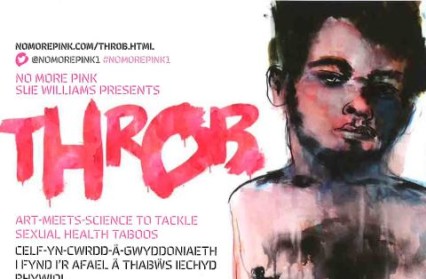Jemma Beggs attended Newport’s Riverfront to review Throb, an exhibition and multi-disciplinary performance to tackle sexual health taboos.
The penultimate performance in a four part series of exhibitions, presentations, poetry and dance, Throb seeks to challenge public perception and break the taboo on erectile dysfunction. It is very much a work-in-progress, in its early stages, welcoming feedback and constructive criticism from the audience. A hybrid of contemporary art, medical research project and campaign to raise awareness on a serious yet sensitive subject, it is currently struggling to get the correct balance on this fusion of art and science.
Throb seeks to merge the two with the help of cardiologist, Dr Nick Ossei-Gerning, who reveals the staggering statistic that almost 100% of his heart attack patients are suffering from erectile dysfunction but, aside from his speech, science does not make any further appearances throughout the performance. Ossei-Gerning mentions the high percentage of divorces which cite erectile dysfunction as a cause, and it this emotional impact ED has on relationships that the performance chooses to explore.
The evening opens in the foyer of Newport’s Riverfront, with introductions from co-directors Sue Williams and Roy Campbell-Moore, followed by Dr Nick Ossei-Gerning’s speech. It is extremely difficult to hear what is being said and, despite Campbell- Moore being co-director, Williams’ frequent corrections of his statements give the impression he does not fully understand the core of Williams’ artistic vision, making for a rather uncomfortable and confused opening.
Unfortunately the discomfort does not end there. Upon entering the studio, the audience make their way to a row of tables and chairs. Projected onto the screen in bold pink writing, are the words “Undress me please!” and that is exactly what we are expected to do. The two dancers and choreographers, Romain Guion and Marta Zollet, wander from table to table asking audience members to remove items of their clothing. Whilst interactive theatre is an extremely popular and exciting theatre trend, watching a lady pull down the fly of a man’s trousers before you’ve had a chance to take your coat off is somewhat alarming. This really warranted a prior warning to save it from being wildly inappropriate.
Finally disrobed, save a pair of black, sequined shorts, the two dancers lay on their backs and embark on a sexual display of slow, languid movements punctuated by short, sharp ones; gently easing open their legs, running their hands past their genitals and casting long, intense gazes at the audience whilst on their knees. This progressed to lewd tongue movements, with the dancers licking their bodies and offering themselves to audience members, panting and groaning as they writhed wildly across the stage.
Choreographed in just two weeks, Guion and Zollet must be commended on their courage to perform such an uninhibited and exposed piece, but the absence of any tangible emotion or chemistry between the two dancers really hindered the performance. Seeking to showcase the devastating effect erectile dysfunction can have on a relationship and the self-esteem of both partners, especially when coupled with a lack of communication, a degree of emptiness and lack of affection for each other is expected, but the journey to this desperate point was missing. Through most of the performance, the dancers were completely expressionless, a poor artistic decision which acted as an audience barrier to empathy and understanding. To see their emotional pain or shame written across their face would have strengthened the intent behind the physical movements of their bodies. There was some measure of frustration and despair evident but it was muted, and the absence of any progression from love to this state of separation kept the performance somewhat one-dimensional.
The dances were interspersed with Sue Williams’ own drawings of faceless men and women suffering from the impacts of erectile dysfunction, as well as a short video she funded and produced herself titled ‘Blink’, which comprised of flashing images showing a woman in various states of sexual passion and frustration, designed to portray ED from a female perspective. Whilst all depicting the same issue, there was no overarching thread pulling all the different components into one consistent piece.
Rhian Edwards’ live reading of her poetry added another layer to the performance. Read and written beautifully, it was this which really brought the performance to life, transforming it into art for brief moments rather than a singularly uncomfortable experience. The desire to raise awareness on such an important, widespread yet taboo subject is admirable, but the execution is muddled, with a seemingly haphazard approach of exploring an array of erectile dysfunction-related content, through a variety of mediums in order to gauge what reaction arises. With the goal to raise awareness for the issue and obtain funding for further medical research, a clearer vision for the practical uses to which the show could be put to, is perhaps necessary if the piece is to have any chance to grow.
Throb












